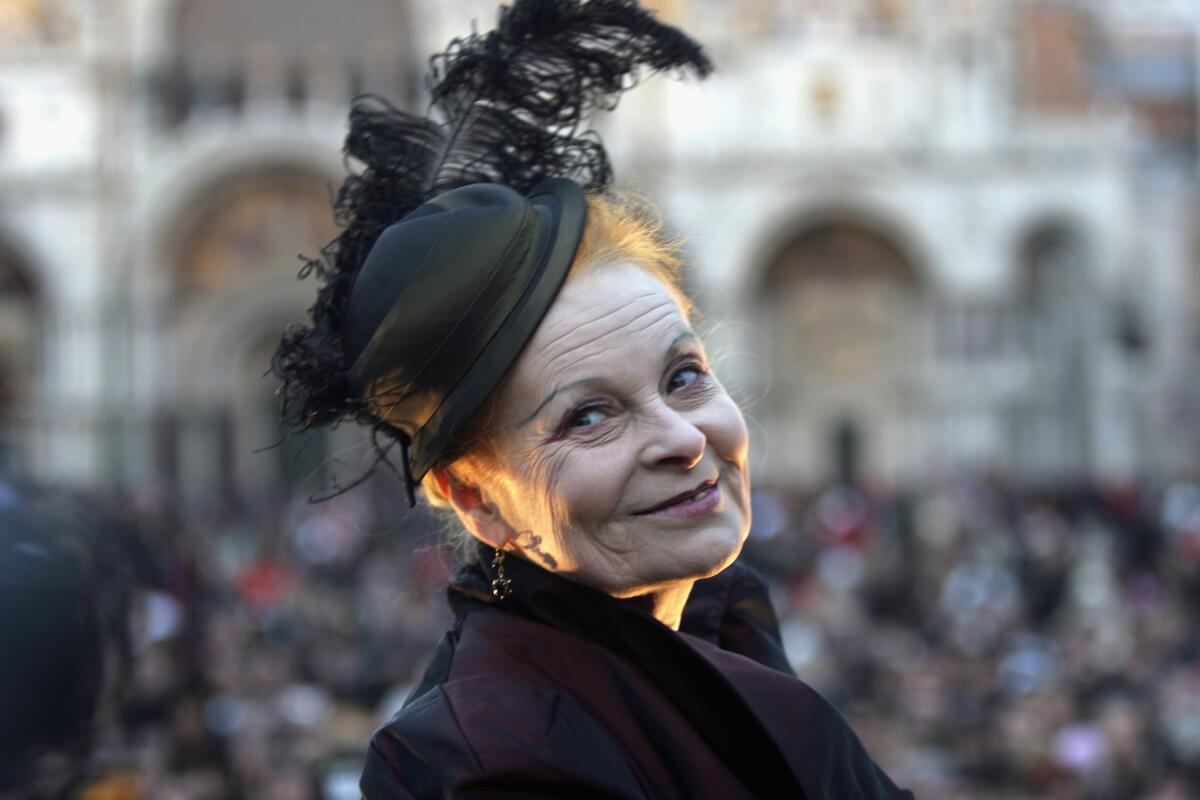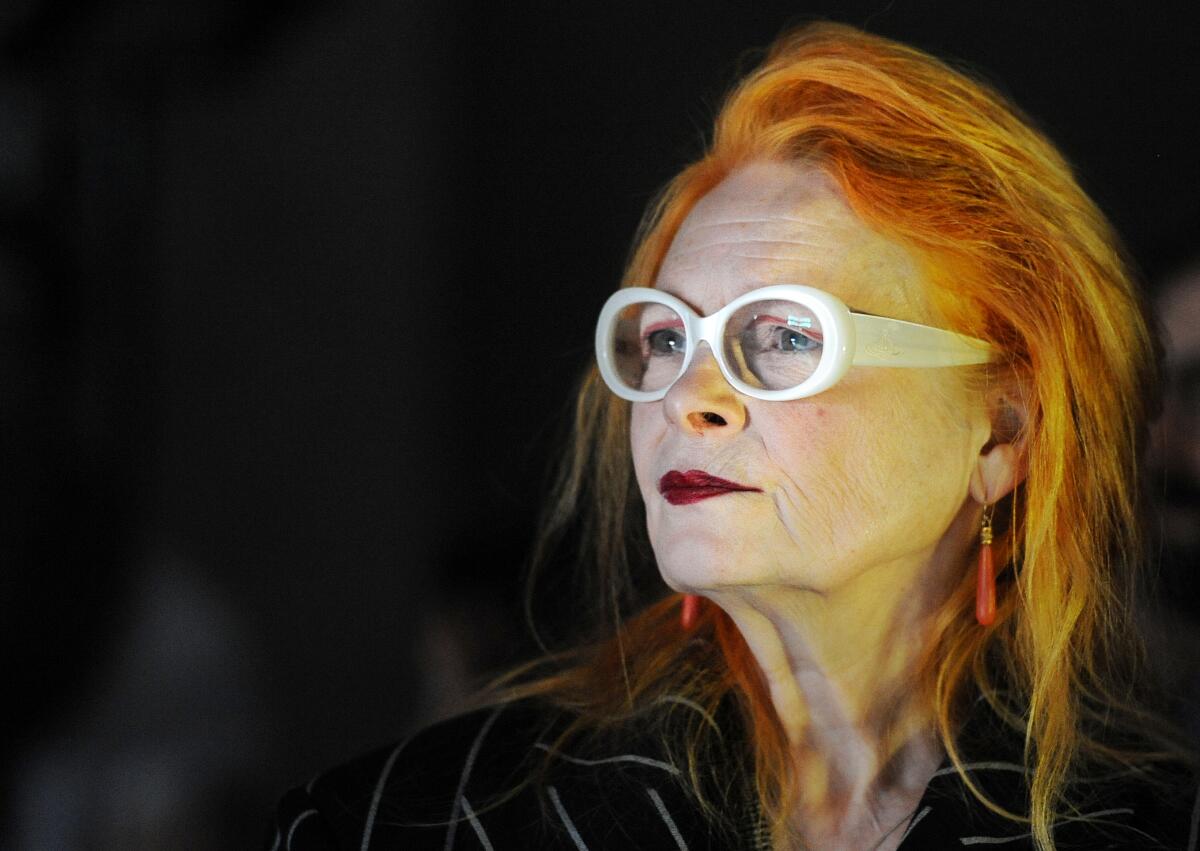Fashion designer and punk icon Vivienne Westwood dies at 81

- Share via
Fashion designer Vivienne Westwood, known for popularizing British punk and new wave fashion, died Thursday at age 81.
“Vivienne Westwood died today, peacefully and surrounded by her family, in Clapham, South London,” said a statement from her fashion house. “Vivienne continued to do the things she loved, up until the last moment, designing, working on her art, writing her book, and changing the world for the better.”
Andreas Kronthaler, Westwood’s husband and longtime creative partner, said they’d “been working until the end and she has given me plenty of things to get on with,” and thanked her.
A major icon in the early British punk scene of the 1970s, Westwood went on to enjoy a long career highlighted by a string of triumphant runway shows in London, Paris, Milan and New York. Westwood’s work, which was often marked by her antiestablishment values, adorned the bodies of numerous celebrities, those on the red carpets of Hollywood as well as those in the British royal family.
Costume designer Jenny Beavan could never afford Vivienne Westwood’s designs. But her punk aesthetic, and the world she inhabited, still left a mark.
In a 2018 review of a Westwood documentary, The Times’ Kenneth Turan described her as “a woman of formidable energy and drive whether she is tearing apart one of her own fashion collections the night before her show or passionately advocating for environmental issues.”
Westwood was born Vivienne Isabel Swire to a working-class family; her father worked at an aircraft factory, and her mother’s family made their living as weavers and cotton spinners. In the late 1950s, Westwood enrolled in the Harrow School of Art but dropped out after the first term.
“I didn’t know how a working-class girl like me could possibly make a living in the art world,” she said. Those blue-collar roots would inform her radical approach to urban street style, which would take the fashion world by storm.

In the late 1960s, while making a living as a primary school teacher and designing and selling her own jewelry on the side, Westwood met Sex Pistols manager Malcolm McLaren, with whom she would later have a son.
They believed that, together, they could wage a social revolution through fashion and rock, and opened their Let It Rock shop on London’s King’s Road in the early 1970s. It became a gathering spot for the punk scene and England’s counterculture. The store was later renamed Sex, a symbolic middle finger to the establishment that prosecuted them under British obscenity laws for making shirts with pornographic images.
During the 1980s, even while she enjoyed mainstream success, Westwood’s work continued to display an antiestablishment flair. She famously posed for a Tatler magazine cover in 1989 as British Prime Minister Margaret Thatcher, styled in a suit that Thatcher herself had ordered but later canceled. In her 2016 book, “Get a Life,” Westwood wrote about the controversial magazine cover, criticizing Thatcher’s conservative economic policies and involvement in the oil industry and its role in climate change.
“You need heart and head to have vision and that’s why I call her a hypocrite: she did not care and used her status as a woman to pretend she did,” Westwood wrote.
From Zendaya to Blake Lively, celebrities embraced Vivienne Westwood’s designs at Hollywood events. Here are her best red carpet gowns.
The name Westwood became synonymous with style and attitude even as she shifted focus from year to year. Her range was vast, and her work was never predictable.
As her stature grew, she seemed to transcend fashion, with her designs shown in museum collections around the world. The young woman who had scorned the British establishment eventually became one of its leading lights, and she used her elite position to lobby for environmental reforms, even as she kept her hair dyed the bright shade of orange that became her trademark.
“She was always trying to reinvent fashion,” Andrew Bolton, curator of the Costume Institute at the Metropolitan Museum of Art in New York told the Associated Press. “Her work is provocative, it’s transgressive. It’s very much rooted in the English tradition of pastiche and irony and satire. She is very proud of her Englishness, and still she sends it up.”
Westwood as a brand also expanded, opening stores throughout Europe and Asia. In 2011, her first U.S. storefront opened in Los Angeles on Melrose Avenue to a loud, star-studded response.
In London, a new generation of designers has something to say -- in acid tones, goat fur and safety pins.
In her later years, Westwood seemed to tire of the clamor and the buzz around her work and held a more grounded view of the punk movement. In a 2000 interview with The Times, she called punk “a heroic attempt at confronting the establishment ... but ultimately it failed.”
“The establishment is a car going 100 miles an hour,” she said. “You can throw blips at it and try to stop it, but you won’t bring it to a halt. It will only go faster with your energy.”
Even so, Westwood remained politically vocal in the final decades of her life. She was a staunch supporter of imprisoned journalist Julian Assange and long criticized the role of capitalism and its contributions to the climate crisis. She was aware of the fashion industry’s role within the crisis, leading to more sustainable production of her clothes. She also called on consumers to buy less, even of the clothes she designed.
The Associated Press contributed to this report.
More to Read
The biggest entertainment stories
Get our big stories about Hollywood, film, television, music, arts, culture and more right in your inbox as soon as they publish.
You may occasionally receive promotional content from the Los Angeles Times.













